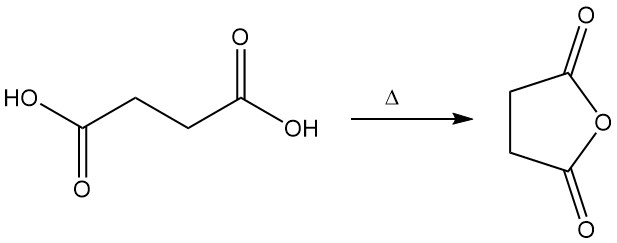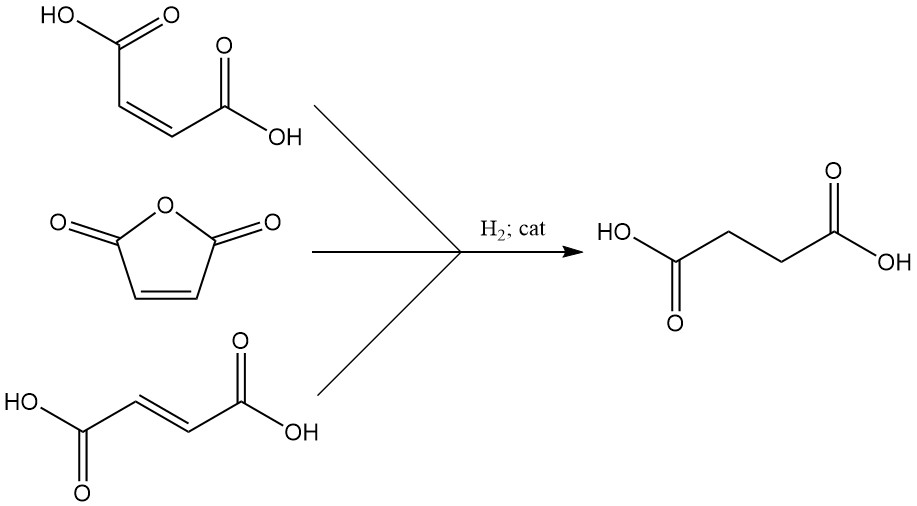Succinic acid: Properties, Production and Uses

What is Succinic Acid?
Succinic acid, also known as butanedioic acid, is a dicarboxylic acid with the chemical formula C4H6O4. It is a colorless crystalline solid that is found in amber, in numerous plants (e.g., algae, lichens, rhubarb, and tomatoes), and in many lignites.
Table of Contents
1. Physical Properties of Succinic Acid
Succinic acid is a colorless, crystalline solid with a very acidic taste. It is soluble in water; its solubility increases with temperature; it is slightly soluble in ethanol, ether, acetone, and glycerin; and it is insoluble in benzene, carbon disulfide, and carbon tetrachloride.
An aqueous solution of succinic acid with a concentration of 0.1 M has a pH of 2.7.
The physical properties of succinic acid are presented in the following table.
| Property | Value |
|---|---|
| CAS number | [110-15-6] |
| Formula | HOOC-(CH2)2-COOH |
| Molecular Mass | 118.08 g/mol |
| Melting Point | 188 °C |
| Boiling Point | 235 °C |
| Density | 1.57 g/cm3 |
| Refractive Index | 1.450 |
| Decarboxylation Temperature | 290-310 °C |
| pKa1 at 25 °C | 4.21 |
| pKa2 at 25 °C | 5.64 |
| Heat of Combustion | -356.32 Kcal/mol |
| Flash Point | 160 °C (open cup) |
2. Reactions of Succinic Acid
Succinic acid, being a dicarboxylic acid, undergoes a variety of reactions characteristic of carboxylic acids. Succinic acid is converted into cyclic anhydride on heating.

It can form both mono- and disalts with bases. For example, reacting with sodium hydroxide can yield sodium hydrogen succinate or sodium succinate.
When the ammonium salt of succinic acid is distilled rapidly, succinimide is formed, with the release of water and ammonia.

Succinic acid reacts with dialcohols to form polyesters and with diamines to form polyamides. The reaction with monoalcohols yields succinate esters. All of these reactions are commercially important.

Succinic acid ester reacts with aldehydes or ketones in the presence of sodium ethoxide or potassium tert-butoxide to form alkylidenesuccinic acid monoesters (Stobbe condensation), which can subsequently be converted into monocarboxylic acids by hydrolysis, decarboxylation, and hydrogenation.

Succinic acid can be reduced to 1,4-butanediol using reducing agents like lithium aluminum hydride.

By heating to temperatures exceeding 310 °C, succinic acid can undergo decarboxylation to form propionic acid and carbon dioxide.
3. Production of Succinic Acid
Succinic acid is produced by diverse synthetic pathways.
Hydrogenation of unsaturated precursors such as maleic acid, maleic anhydride, or fumaric acid yields succinic acid efficiently. Catalysts for this process commonly include Raney nickel, copper, nickel oxide, copper-zinc-chromium, palladium-alumina, palladium-calcium carbonate, or nickel-diatomite.

Alternatively, succinic acid is produced by the oxidation of 1,4-butanediol. Oxidizing agents include oxygen in alkaline-earth hydroxide solution with palladium carbon catalyst at 90–110 °C, ozone in aqueous acetic acid, or nitrogen tetroxide at low temperature.

Reppe carbonylation of ethylene glycol, catalyzed by rhodium trichloride-pentachlorothiophenol, or palladium-catalyzed methoxycarbonylation of ethylene also produce succinic acid or its esters. Additional carbonylation processes using acetylene, acrylic acid, dioxane, or β-propiolactone produce similar results.

Succinic acid is a byproduct in certain oxidation processes, such as adipic acid manufacture, enanthic acid oxidation, and palmitic acid ozonolysis.
Bio-based production of succinic acid is also feasible. BioAmber has commercialized a fermentation process using glucose from wheat starch hydrolysis. The company operates a 2000 ton-per-annum facility in France and plans another in Canada.
Other synthetic routes to succinic acid include phase-transfer-catalyzed reactions of 2-haloacetates, electrolytic dimerization of bromoacetic acid or its ester, oxidation of 3-cyanopropanal, and fermentation of n-alkanes.
4. Uses of Succinic Acid
Succinic acid is used as a raw material in the production of alkyd resins, dyes, pharmaceuticals, and pesticides.
It is also used in the synthesis of polyesters by reaction with glycols, and esters formed by reaction with monoalcohols are important plasticizers and lubricants.
Succinic acid is used in the food and beverage industry as an acidity regulator and flavor enhancer, and in pharmaceuticals as an excipient and active ingredient in some drugs such as metoprolol succinate, sumatriptan succinate, and doxylamine succinate.
5. Toxicology of Succinic Acid
Succinic acid shows low acute toxicity. It can irritate the skin, eyes, and lungs. If swallowed, it can be harmful. The acute oral toxicity in rat (LD50) was 2260 mg/kg
Oral LD50 is determined as >6740 mg/kg body weight, extrapolated from monosodium succinate data. Dermal LD50 is assumed to be identical to oral LD50, aligning with conservative estimation practices.
Inhalation LC50 is calculated as >1284 mg/m³ air based on fumaric acid read-across and particle size considerations.
Fumaric and succinic acids share structural similarity, both being naturally occurring citric acid cycle intermediates. Physicochemical properties and toxicity profiles are comparable. Derek analysis, a toxicity prediction tool, reveals no toxicity alerts for either compound.
Given the high LD50 values for oral and dermal exposure and the estimated LC50 exceeding the maximum feasible concentration, no classification is warranted.
References
- Dicarboxylic Acids, Aliphatic; Ullmann’s Encyclopedia of Industrial Chemistry. – https://onlinelibrary.wiley.com/doi/10.1002/14356007.a08_523.pub3
- https://pubchem.ncbi.nlm.nih.gov/compound/Succinic-Acid
- https://echa.europa.eu/registration-dossier/-/registered-dossier/15265/7/3/1
- https://www.flinnsci.com/sds_788-succinic-acid/sds_788/
